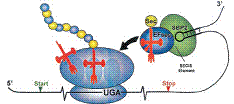Biochemistry, Department of

Vadim Gladyshev Publications
Document Type
Article
Date of this Version
2009
Abstract
Boron is a micronutrient in plants and animals, but its specific roles in cellular processes are not known. To understand boron transport and functions, we screened a yeast genomic DNA library for genes that confer resistance to the element in Saccharomyces cerevisiae. Thirty boron-resistant transformants were isolated, and they all contained the ATR1 (YML116w) gene. Atr1 is a multidrug resistance transport protein belonging to the major facilitator superfamily. C-terminal green fluorescent protein-tagged Atr1 localized to the cell membrane and vacuole, and ATR1 gene expression was upregulated by boron and several stress conditions. We found that atr1Δ mutants were highly sensitive to boron treatment, whereas cells overexpressing ATR1 were boron resistant. In addition, atr1Δ cells accumulated boron, whereas ATR1-overexpressing cells had low intracellular levels of the element. Furthermore, atr1Δ cells showed stronger boron-dependent phenotypes than mutants deficient in genes previously reported to be implicated in boron metabolism. ATR1 is widely distributed in bacteria, archaea, and lower eukaryotes. Our data suggest that Atr1 functions as a boron efflux pump and is required for boron tolerance.


Comments
Published in MOLECULAR AND CELLULAR BIOLOGY, July 2009, p. 3665–3674 Vol. 29, No. 13. Copyright © 2009, American Society for Microbiology. Used by permission.